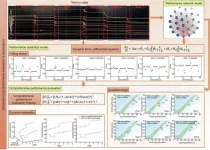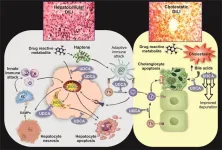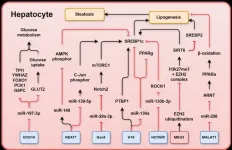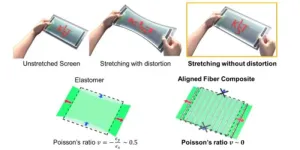CFRP and UHPC: New insights into strengthening reinforced concrete beams under thermocyclic distress
2025-02-28
(Press-News.org)
A recent study published in Engineering delves into the behavior of reinforced concrete beams strengthened with Carbon Fiber Reinforced Polymer (CFRP) and Ultra-High-Performance Concrete (UHPC) under thermocyclic loading. This research, conducted by Ju-Hyung Kim and Yail J. Kim, aims to understand the effects of multi-hazard loading on these strengthened structures, which is crucial for the maintenance and rehabilitation of existing buildings.
Multi-hazards, such as the combination of seismic events and high temperatures, pose a significant threat to the functionality of buildings. Conventional design practices often fall short in addressing these complex loading conditions. The use of CFRP and UHPC in strengthening concrete members has been proven effective, but their performance under thermocyclic distress remains unclear.
The researchers built on a previous experimental study where load reversals were carried out at temperatures ranging from 25 to 175 °C. They developed an analytical approach to quantify the uncertainty in the hysteretic behavior of the strengthened beams. By comparing the responses of a reference model with experimental measurements, they found that the uncertainty index increased with the drift ratio of the beams. At 175 °C, the uncertainty indexes of CFRP-strengthened (CF) and CFRP/UHPC-strengthened (UC) beams reached as high as 0.35 and 0.37, respectively. This increase in uncertainty correlated with a reduction in the energy capacity of the beams.
The study also explored the hysteretic system of the strengthened beams. The adjusted stiffness of the hysteresis loop was found to indicate damage accumulation and deformation resistance. When plastic hinges formed, a large amount of energy was dissipated. Two hysteresis models, mean and regression, were proposed. The mean model was more suitable when the temperature was below the glass transition temperature of CFRP, while the regression model was better for higher temperatures.
Regarding the pinching mechanism, the researchers found that the magnitude of drift ratios had a greater impact on the progression of pinching compared to the retrofit materials. Although the installation of a UHPC jacket was beneficial in maintaining the stable pattern of hysteresis loops at lower temperatures, thermal damage between the concrete substrate and UHPC at higher temperatures affected its performance.
To aid in practical design, the researchers proposed a performance degradation factor. This factor can be used to estimate the degraded energy dissipation capacity of the beams under thermocyclic distress. The values of this factor range from 1.00 to 0.45, depending on the temperature and the retrofit scheme.
This research provides valuable insights into the behavior of CFRP/UHPC-strengthened reinforced concrete beams under thermocyclic distress. The findings can help engineers make more informed decisions when designing and retrofitting structures to withstand multi-hazard conditions, contributing to the safety and durability of buildings in the face of complex environmental challenges.
The paper “Hysteretic Uncertainty and Anomaly Quantification of Reinforced Concrete Beams Strengthened with Carbon Fiber Reinforced Polymer and Ultra-High-Performance Concrete in Thermocyclic Distress,” authored by Ju-Hyung Kim, Yail J. Kim. Full text of the open access paper: https://doi.org/10.1016/j.eng.2024.11.018. For more information about the Engineering, follow us on X (https://twitter.com/EngineeringJrnl) & like us on Facebook (https://www.facebook.com/EngineeringJrnl).
END
[Attachments] See images for this press release:

ELSE PRESS RELEASES FROM THIS DATE:
2025-02-28
Paul Armsworth, Distinguished Service Professor in the Department of Ecology and Evolutionary Biology at the University of Tennessee, Knoxville, has received a 2025 Southeastern Conference Faculty Achievement Award for excellence in teaching, research and service.
He and the 15 other recipients this year — one from each SEC member university — are now nominated for the SEC Professor of the Year Award, which will be announced later in the spring.
“I am thrilled to receive this recognition, but it is also very humbling to be celebrated in this ...
2025-02-28
A recent study published in Engineering presents a groundbreaking method for comprehensively evaluating the performance of aeroengines, the crucial components powering aircraft. Authored by Shubin Si and other researchers from esteemed institutions in China, this research addresses long-standing challenges in aeroengine performance assessment.
Aeroengines are complex systems, and their performance directly impacts flight safety and efficiency. Traditional evaluation methods, such as airlines relying on single-parameter indicators like exhaust gas temperature or manufacturers conducting ...
2025-02-28
A study led by UMass Chan researchers demonstrated that a gene therapy to correct a mutation that causes maple syrup urine disease (MSUD) prevented newborn death, normalized growth, restored coordinated expression of the affected genes and stabilized biomarkers in a calf as well as in mice.
“Simply put, we believe the gene therapy demonstrated in both animal species, especially in the cow, very well showcases the therapeutic potential for MSUD, in part because the diseased cow, without treatment, has a very similar metabolic profile as the patients,” said Dan Wang, PhD, assistant ...
2025-02-28
Drug-induced liver injury (DILI) is a significant concern in clinical practice, arising from medications, herbs, and dietary supplements. It can manifest in different forms, including hepatocellular, cholestatic, and mixed types, each associated with specific liver enzyme abnormalities and histological injury patterns. Hepatocellular DILI is characterized by inflammation, necrosis, and apoptosis, while cholestatic DILI involves bile plug formation and bile duct paucity. Ursodeoxycholic acid (UDCA), a widely used treatment for cholestatic liver diseases, has recently been investigated for its potential therapeutic effects ...
2025-02-28
Hepatic biliary adenofibroma (BAF) is a rare benign bile duct neoplasm that has garnered increasing attention due to its potential role as a precursor lesion for intrahepatic cholangiocarcinoma (iCCA). Although it shares histopathological features with other biliary tumors, BAF is distinct in its composition, consisting of low-grade tubuloglandular and microcystic bile duct structures embedded in a dense fibrous stroma. Despite its classification as a benign tumor, emerging case reports suggest that BAF may undergo malignant transformation. However, its rarity and limited molecular characterization contribute to diagnostic ...
2025-02-28
Metabolic dysfunction-associated steatotic liver disease (MASLD), formerly known as non-alcoholic fatty liver disease (NAFLD), is a global health challenge, affecting nearly 30% of adults worldwide. A significant subset of MASLD patients progresses to metabolic dysfunction-associated steatohepatitis (MASH), liver fibrosis, and even hepatocellular carcinoma (HCC), yet no universally approved treatment exists outside resmetirom. The increasing prevalence of MASLD, driven by obesity and diabetes, highlights an urgent need for innovative therapeutic ...
2025-02-28
McMaster University researchers have identified small molecules in the blood that may impact early childhood development, showing how dietary exposures, early life experiences, and gut health can influence a child's growth and cognitive milestones.
A McMaster team collaborated with Brazilian scientists to conduct an untargeted metabolomic analysis of blood samples taken from more than 5,000 children between the ages of six months and five years as part of the Brazilian National Survey of Child Nutrition study.
The McMaster team found several metabolites – small molecules that are by-products of human metabolism and microbial fermentation, ...
2025-02-28
Giant pandas have digestive systems that are typical for carnivores. Yet, bamboo is their main source of food. They have evolved several features, for example pseudo thumbs to grasp bamboo and flat teeth that are well suited for crushing it, that make it possible for them to live off plants.
All living organisms have DNA, which stores the genetic information in a cell, and RNA, which carries and transfers this information. MicroRNAs (miRNA) are small non-coding RNAs that play an important role in gene expression, the process of turning the information encoded in a gene into a function. ...
2025-02-28
Stretchable display materials, which are gaining traction in the next-generation display market, have the advantage of being able to stretch and bend freely, but the limitations of existing materials have resulted in distorted screens and poor fit. General elastomeric substrates are prone to screen distortion due to the 'Poisson's ratio' phenomenon, in which stretching in one direction causes the screen to shrink in the vertical direction. In particular, electronics that are in close contact with the skin, such as wearable devices, are at risk of wrinkling or pulling on the skin during stretching and shrinking, resulting in ...
2025-02-28
By Alistair Jones
SMU Office of Research – Even by the standards of medical terminology, photoplethysmography (PPG) is a mouthful. Yet it is widely used in clinical settings as a non-invasive, optical technique for measuring the oxygen saturation level in the blood, and the pulse rate, as vital signs of a patient. It is commonly encountered as a clip-on oximeter attached to a finger.
First developed in the 1930s, PPG emits light to illuminate the microvascular bed of the skin. Then a photodiode, positioned alongside the light emitter, captures the reflected light, termed the PPG waveform, which ...
LAST 30 PRESS RELEASES:
[Press-News.org] CFRP and UHPC: New insights into strengthening reinforced concrete beams under thermocyclic distress







